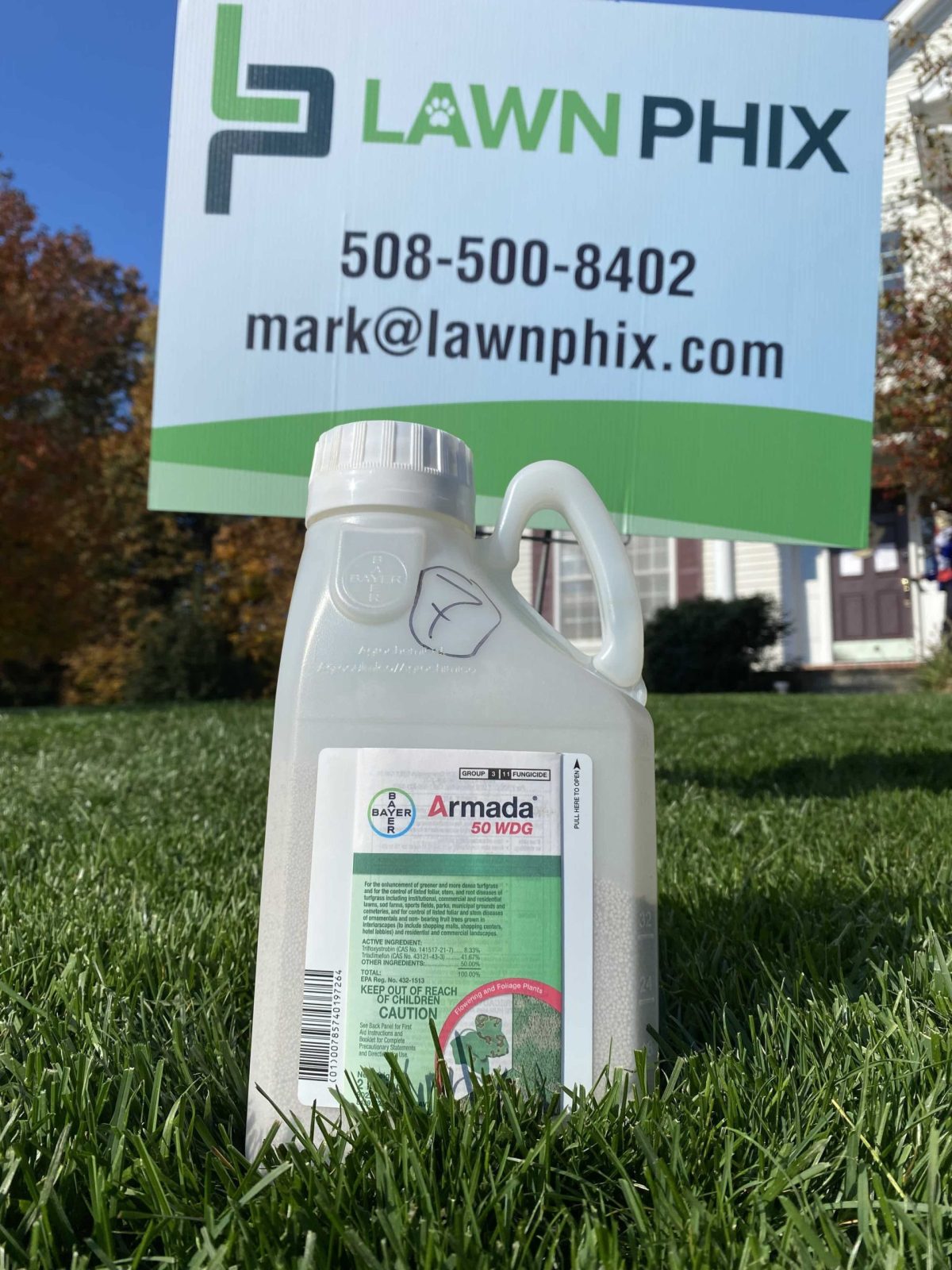LAWN PHIX PRO PICK
After testing the best products side by side, I found Armada 50 WDG to be the best lawn fungicide available. It worked the best out of any systemic fungicide I’ve used, and I saw firsthand how the two-way formula stopped diseases faster and more effectively.
Pro Tip: tank mix with yucca or a non-ionic surfactant for improved surface area coverage.
2024 is set for above-average moisture and humidity, which means we need to brace ourselves for lots of fungus and disease. If you’ve had problems with red thread, dollar spot, and brown patch before, things aren’t going to get any easier this year.
I’ve been battling lawn diseases and fungi for years — both at home on my own lawn and professionally on several thousand acres since 2019. After testing countless lawn fungicides over the years, I’m ranking my list of the top five below:
- Propiconazole 14.3: Best for Group 3
- Artavia 2 SC: Best for Group 11
- Armada 50 WDG: Best for all-in-one solutions
- Pillar G Intrinsic Granular Fungicide: Best for granular applications
- Clearys 3336F Fungicide: Best for broad-spectrum disease prevention
Keep in mind these are in three different FRAC groups, so they’re safe and effective for the treatment of fungus. I recommend rotating Group 1, Group 3, and Group 11 products (Thiophanate-methyl, Propiconazole or Myclobutanil, and Azoxystrobin, respectively) for the best possible results.
Here’s what you should know about these five lawn fungicides, including how to apply them.
| FRAC GROUP | PRODUCT | INGREDIENT (AI) |
|---|---|---|
| Best Group 1 | Clearys 3336F | Thiophanate-methyl |
| Best Group 3 | Propiconazole 14.3 | Propiconazole |
| Best Group 11 | Artavia 2SC | Azoxystrobin |
| Best Granular | Heritage G | Azoxystrobin |
| Best Combo | Pillar G | Pyraclostrobin and Triticonazole |
Table of Contents
But first, what is a fungicide?
Lawn fungicides prevent and control fungal diseases in grass. They don’t cure or fix any infected grass but stop the growth and spread of the disease in the plant.
FYI: I prefer liquid fungicides over granular fungicides. When applied to turf with an active lawn disease, liquids provide a “curative” response that slows their roll and protects the rest of your lawn.
And what is a fungicide group?
Like lawn pests, fungi can become resistant to products, which makes them incredibly difficult to control. Fungicide groups were established to combat this by introducing new chemicals and disrupting the resistance process.
Fungicides fall into different classes or families according to their chemical makeup. Each group contains a common name – and trade – name for easy identification, along with a code from the FRAC (or the Fungicide Resistance Action Committee).
The full list of FRAC codes is unbelievably expansive and includes cross-resistance patterns and modes of action. We’re mainly focused on the numbers — these are key to preventing fungicide resistance.
To summarize:
- Fungi become resistant to products with the same basic makeup.
- Rotating products ensures they can’t develop this resistance and die off instead.
- FRAC codes appear on fungicide labels so you can check your math on the spot.
If you plan to treat lawn fungi, please don’t forget to rotate your products. The last thing you want is a ‘Frankenstein’ strain that spreads to the neighbor’s lawn.
Prepare to purchase at least two products (and budget accordingly).
Top 5 Lawn Fungicides Explained
Two or three of these effective fungicides can work wonders on your lawn.
I recommend starting with this product first:
1. Propiconazole 14.3
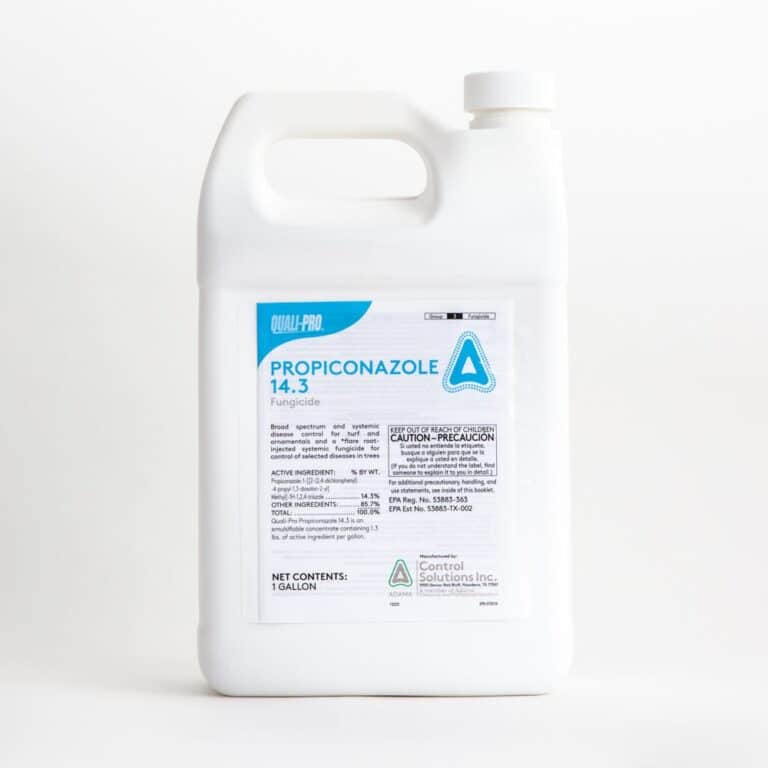
Quite possibly the most economical and effective systemic fungicide out there, Propiconazole can prevent and control turf diseases for up to three weeks.
For the price, it should be on your shelf and in regular rotation. I use 2 oz. per 1,000 sq. ft. in early-mid spring as my first-round lawn fungicide.
Lawn Phix Review
Propiconazole at 2-4 oz. per 1,000 sq. ft. is a great option at the end of the season to prepare your lawn for winter and help prevent snow mold in the spring. It can also control and treat many other lawn diseases in your landscape beds. I’ve recently treated anthracnose in my azalea this year with both Propiconazole and Artavia 2SC (above), and it is now in full bloom!
PROS
What we liked.
- Most economical
- Best for snow mold
- Mixes with other FRAC groups
CONS
What we didn’t like.
- Often overused
- Can cause phytotoxicity
Propiconazole 14.3 Application Rates
Purchasing a gallon of Propiconazole 14.3 and applying minimum rates for brown patch costs $0.90 per 1,000, while 2 oz. per 1,000 sq. ft. is just $1.81 per 1,000 sq. ft. application. The 128 oz. jug will cover over an acre of turf at the 2oz. per 1,000 sq. ft. application rates.
Propiconazole 14.3 Specifications
- Active Ingredients: Propiconazole
- Target Funguses: Brown Patch, Dollar Spot, Leaf Spot, Pink & Gray Snowmold, Powdery Mildew, Rust, and more.
- FRAC Group 3
Fungi targeted: Brown Patch, Dollar Spot, Leaf Spot, Pink & Gray Snowmold, Powdery Mildew, Rust, and more.
Find the latest price on Propiconazole 14.3 at Do My Own, Lawn Pro, DIY Pest, and Amazon.
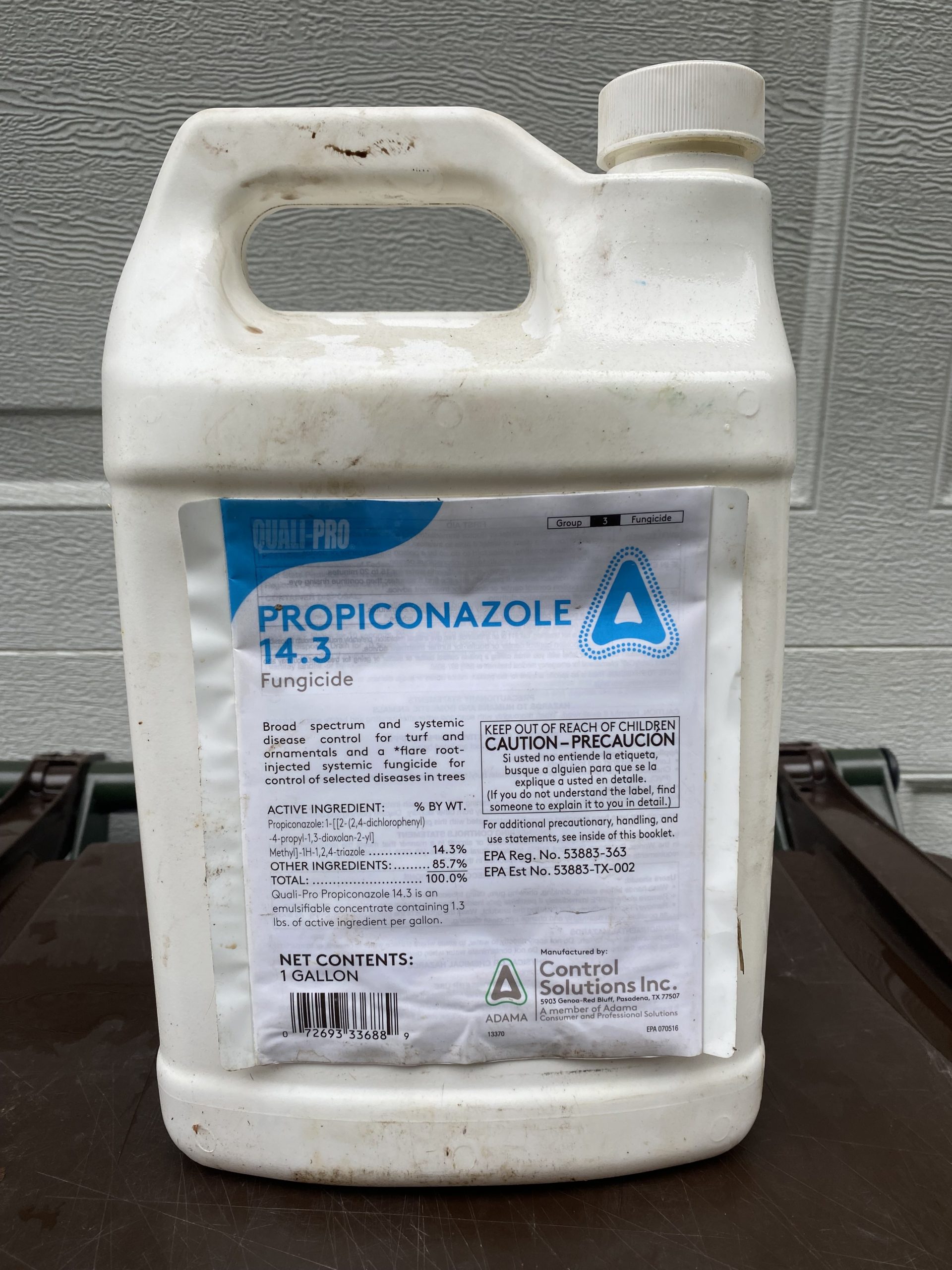

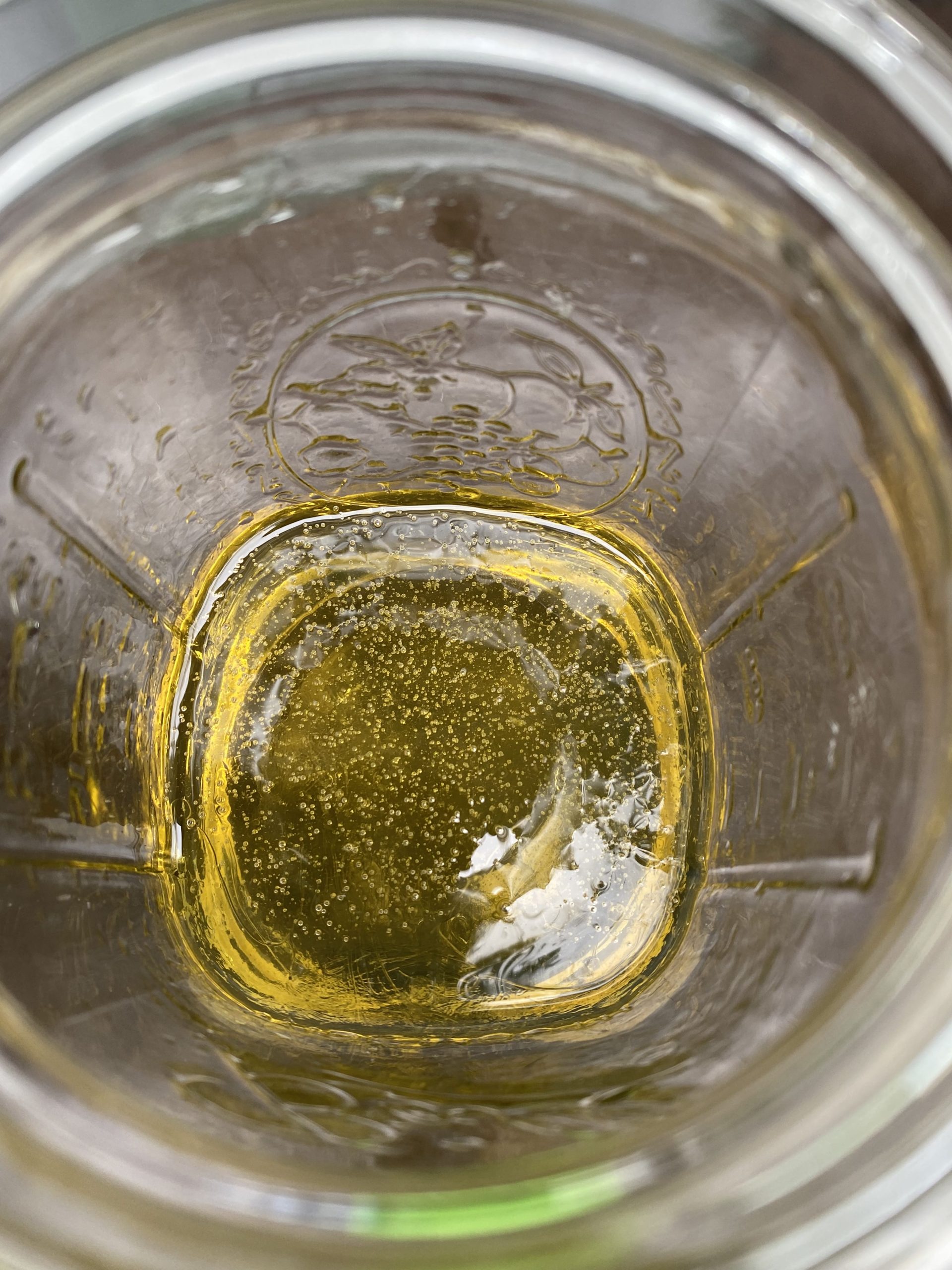
2. Artavia 2 SC
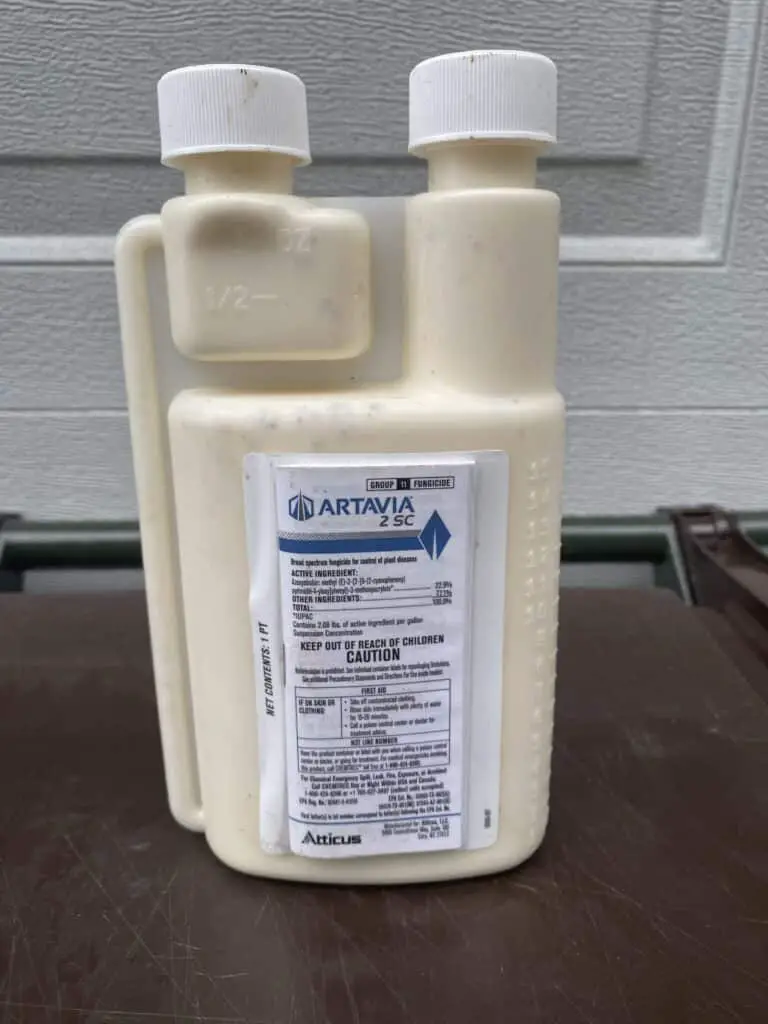
Azoxystrobin is one of the most powerful ingredients against many diseases, and Artavia 2 SC is a terrific broad-spectrum liquid fungicide.
While it’s more expensive upfront than Propiconazole, low rates will cover almost an acre of turf. It also uses the same active ingredient as Heritage G (granular), which means it’s a good generic option at a much more affordable cost.
Lawn Phix Review
[BEFORE/AFTER PICS, OR POST-APPLICATION PICS]
This product, alternatively applied with Propiconazole, will be one of the best 1-2 combinations in preventing lawn diseases like brown patch fungus. For a granular alternative, Syngenta Heritage G is the way to go.
These two products and fungicides must be on your shelves to prevent fungal lawn diseases. I will apply Artavia at the end of May as my Round 2 application. I successfully use Artavia 2SC on my hydrangeas to help prevent things like leaf spot.
PROS
What we liked.
- Low application rates
- Highly effective in rotation
- Versatile usages – lawns and ornamentals
CONS
What we didn’t like.
- It cannot be used to treat dollar spot
- Relatively expensive cost
Artavia 2 SC Application Rates
Apply just 0.38-0.77 oz. per 1,000 for 10-28 days of disease coverage (depending on the type of fungus). Try our Azoxystrobin calculator to help you get the exact amount you need for your lawn.
Artavia 2 SC Specifications
- Active ingredient(s): Azoxystrobin
- Targeted funguses: Over a dozen diseases, including Brown Patch, Leaf Spot, Melting Out, Red Thread, Pythium Blight, Snow Mold, Take All Patch, and more.
- FRAC Group: 11
Find the latest price on Artavia 2SC at Do My Own and Lawn Pro.
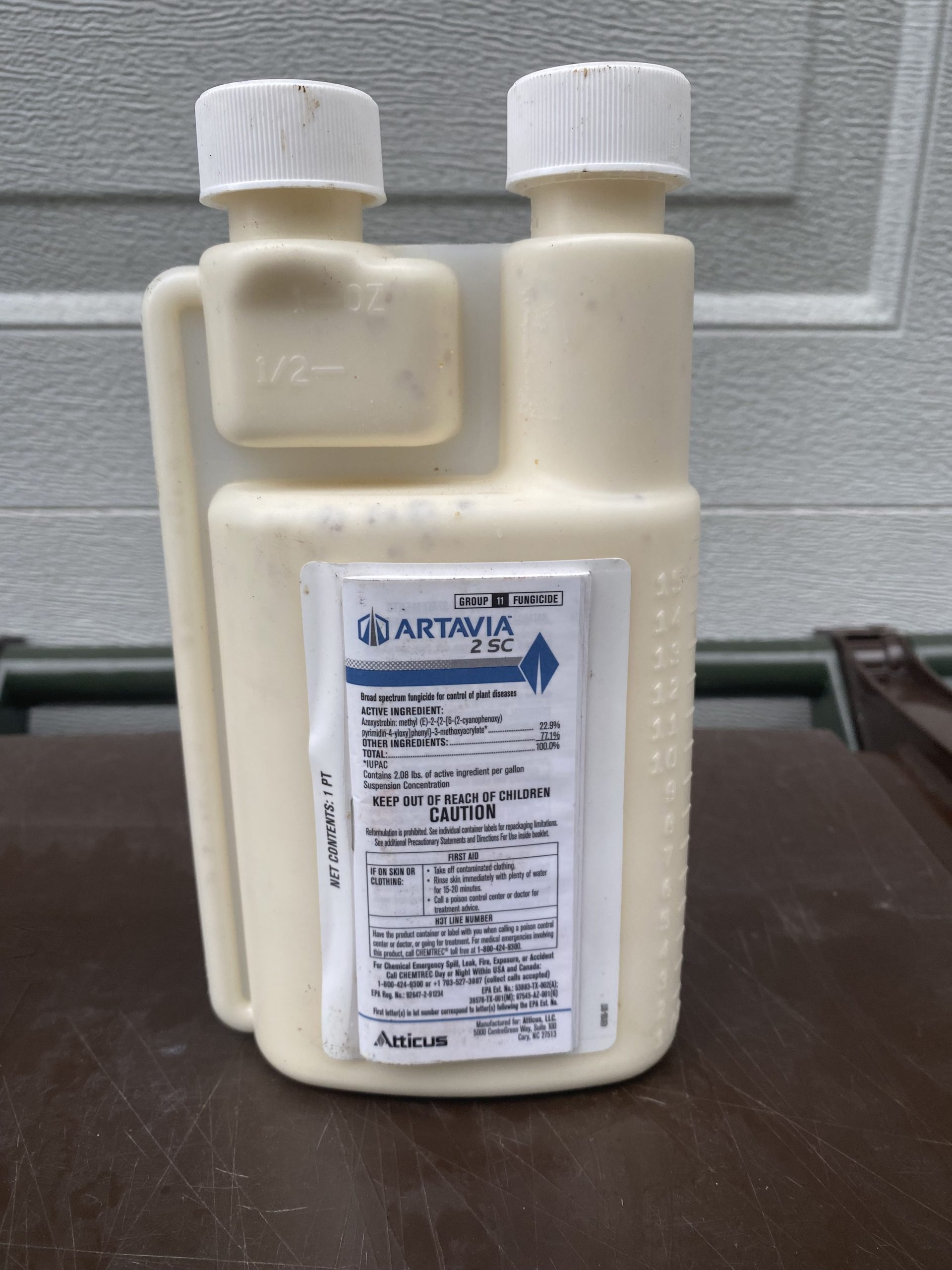
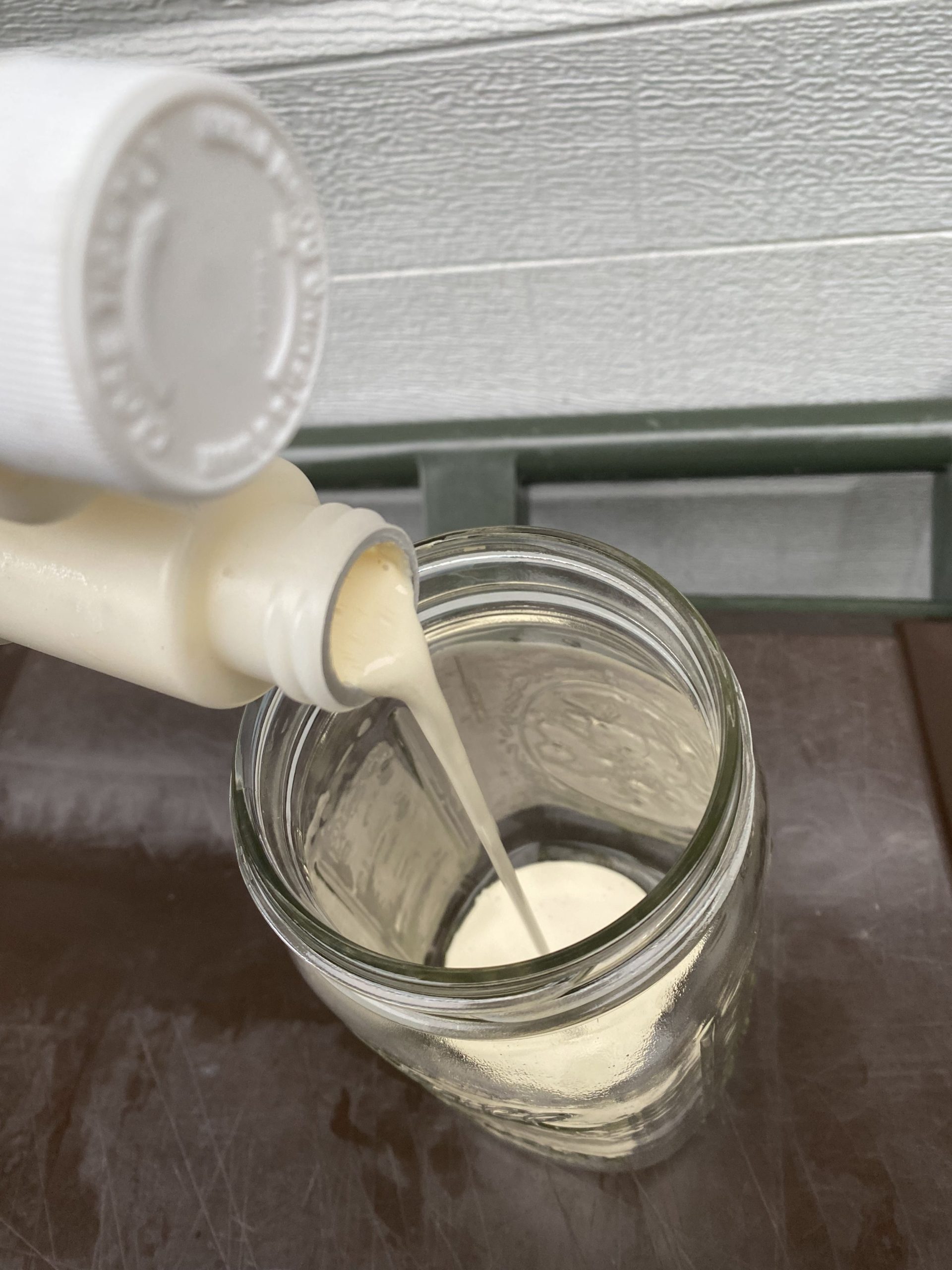
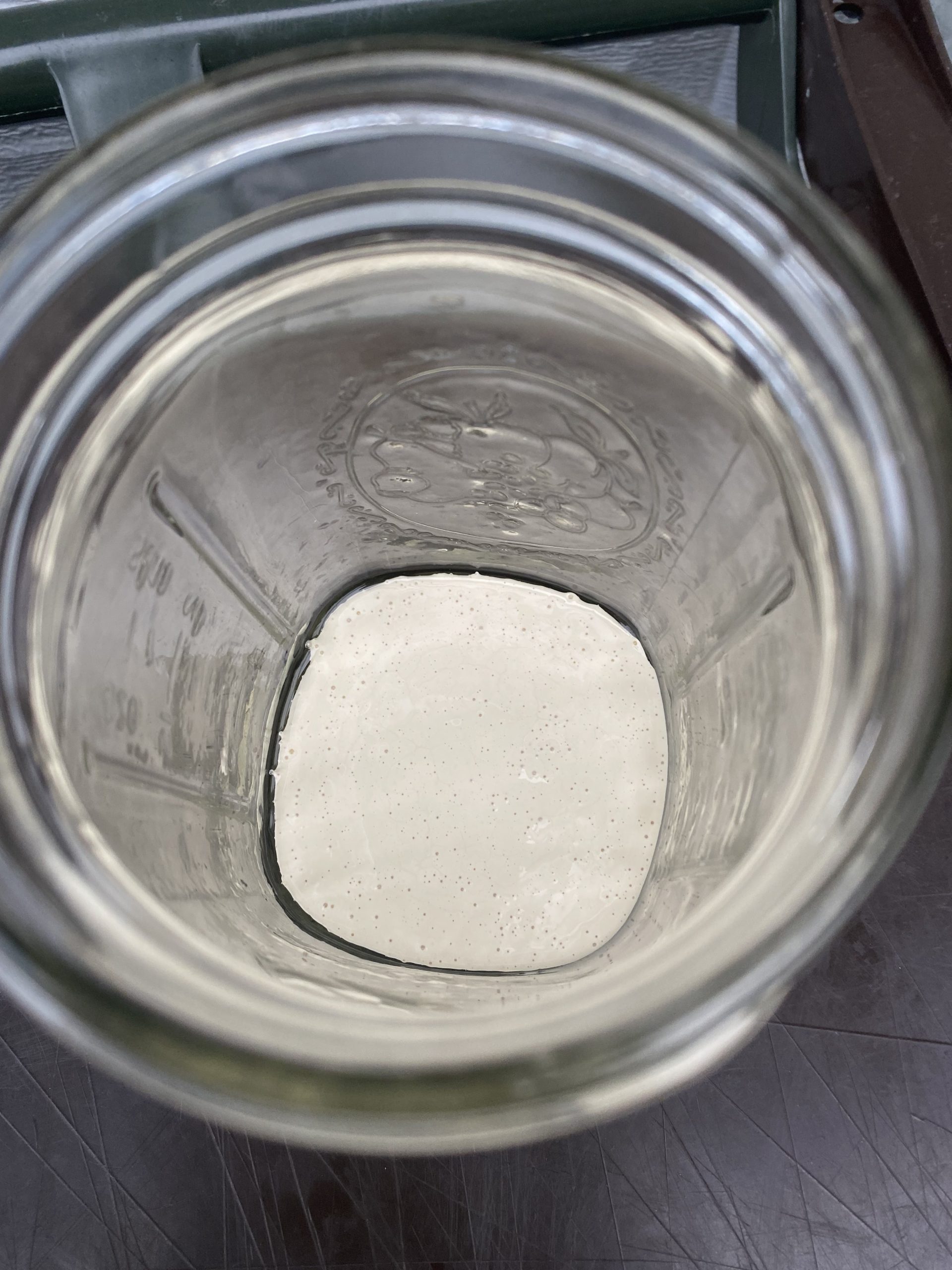
3. Armada 50 WDG
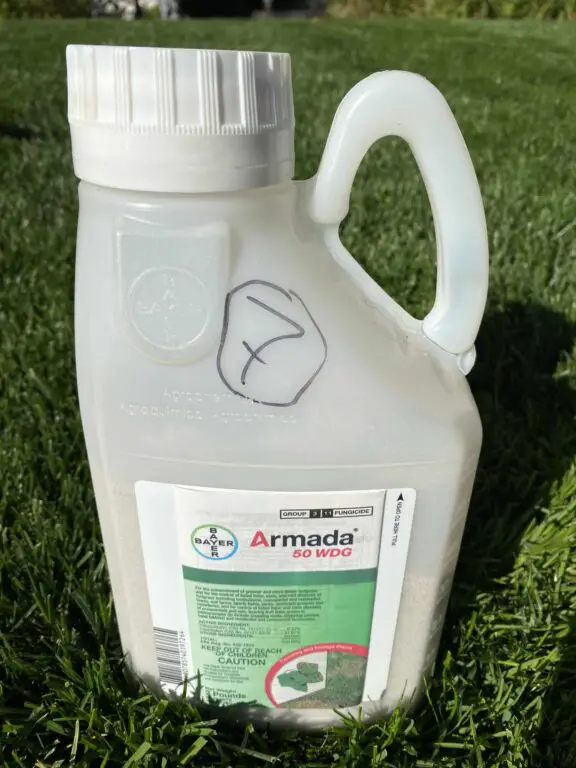
- Active Ingredients: Triadimefon and Trifloxystrobin
- Target Funguses: Brown Patch, Dollar Spot, Leaf Spot, Rust, Pink Snow Mold, and more.
- FRAC Group 3 & 11
Armada 50 WDG is a terrific option for those looking for an all-in-one solution. It is a powerful combination of FRAC 3 and FRAC 11 fungicides. This water dispersible granule (WDG) needs to be mixed and fully dissolved and suspended before spraying. Use up to 1.5 ounces (42.5 grams) per gallon per 1,000 sq. ft.
Lawn Phix Review


The pictures above are of a two year customer with a brutal disease in the late spring. I treated this with liquid nutrition (sea kelp, iron, calcium, yucca) and max rates of Armada 50 WDG. Since I did not treat this previously with prevention applications, curative rates were needed. Since this is a dual-FRAC fungicide, I would have opted for a Thiophanate-methy based fungicide (Group 1).
PROS
What we liked.
- Quick response and recovery
- Covers broad range of diseases
- Extended prevention duration
CONS
What we didn’t like.
- WDG and not liquid concentrate
- Cannot use another FRAC 3 or 11 group immediately before or after
Armada 50 WDG Application Rates
Use up to 1.5 ounces (42.5 grams) per gallon per 1,000 sq. ft.
Armada 50 WDG Specifications
Use this broad-spectrum fungicide early to help mitigate many fungus issues earlier in the season. Make sure to rotate with other non-Group 3 or 11 grass fungicides every two applications.
Find the latest price on Armada at Do My Own, DIY Pest, and Amazon.
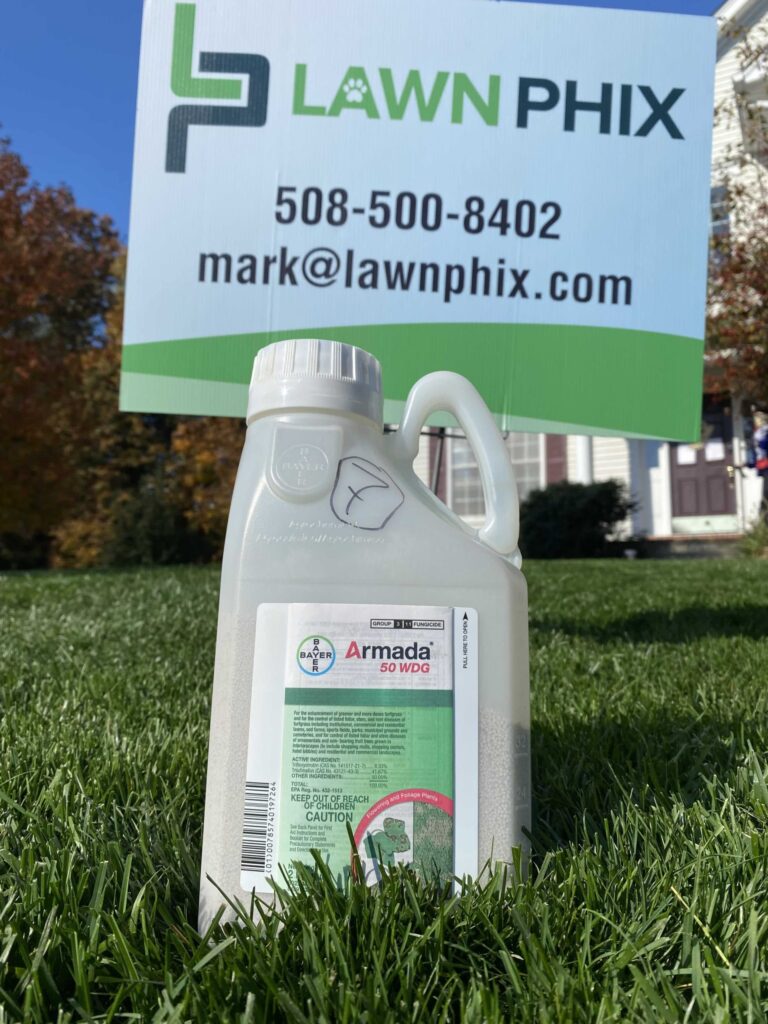
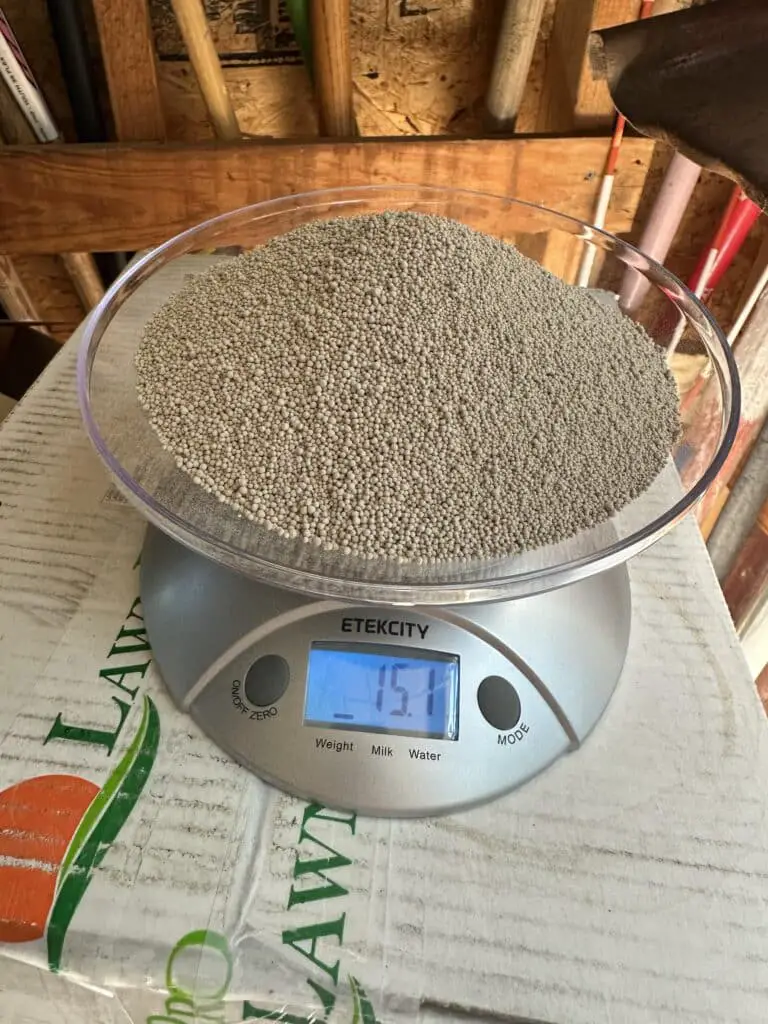
4. Pillar G Intrinsic Granular Fungicide
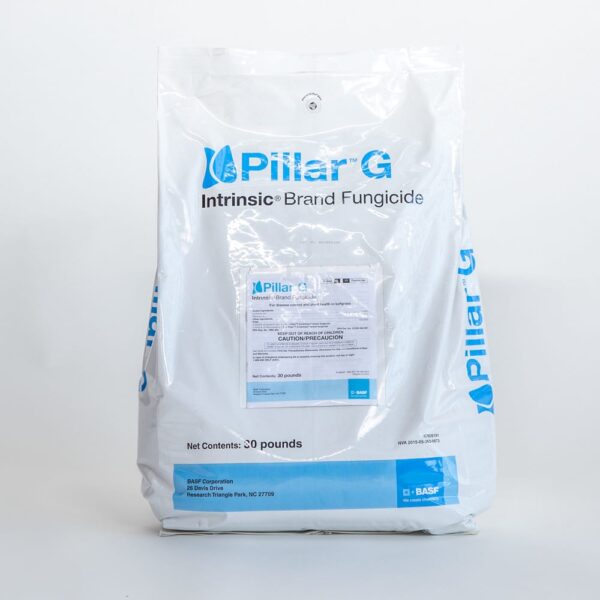
- Active Ingredients: Pyraclostrobin and Triticonazole
- Target Funguses: Over 20 diseases, including Brown Patch, Dollar Spot, Melting Out, Pythium Blight, Red Thread, Rust, and more.
- FRAC Group 3 & 11
Pillar G is one of the few granular fungicides that we recommend. Generally speaking, liquid fungicides are much better options for lawn fungus control. Granules need to be watered into the soil, and their ingredients are drawn up through the roots; liquids can be sprayed directly onto the grass blades with a backpack sprayer and become more quickly activated into the grass foliar.
Best used as a prevention. Apply 3 lbs. of Pillar G per 1,000 sq. ft. to control a broad spectrum disease prevention of funguses. Be sure to rotate with other non-Group 3 or 11 fungicides every two applications to best control lawn disease.
Find the latest price on Pilar G at Do My Own, DIY Pest, and Amazon.
5. Clearys 3336F Fungicide
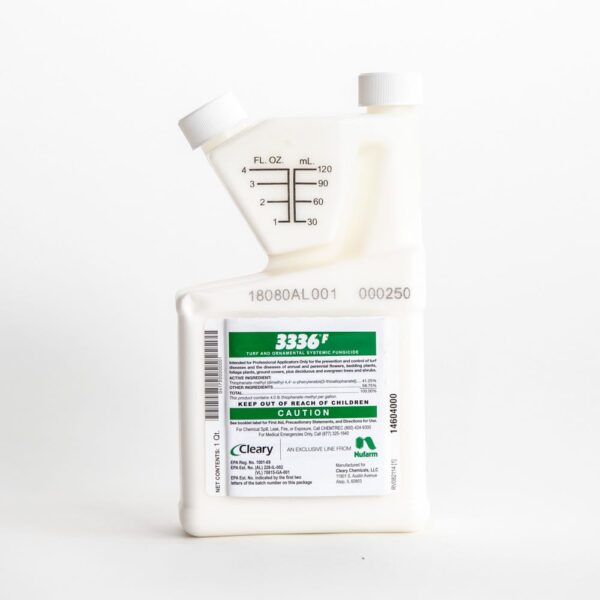
- Active Ingredients: Thiophanate-methyl
- Target Funguses: Anthrancose, Brown Patch, Dollar Spot, Leaf Spot, Red Thread, Snow Mold, Rust, Summer Patch, and more.
- FRAC Group 1
Clearys 3336 F fungicide is a broad-spectrum disease prevention fungicide providing very good disease prevention and curative properties for turfgrasses. This FRAC 1 fungicide is a great option to rotate with any of these other fungicides listed in this post (FRAC 3 & 11). Apply between 2-6 oz. per 1,000 sq. ft. depending on the type of fungal disease.
Note: there are several restrictions and may not be available in your state.
Find the latest price on Clearys at Do My Own, Lawn Pro, DIY Pest, and Amazon.
5. Eagle 20EW Specialty Fungicide
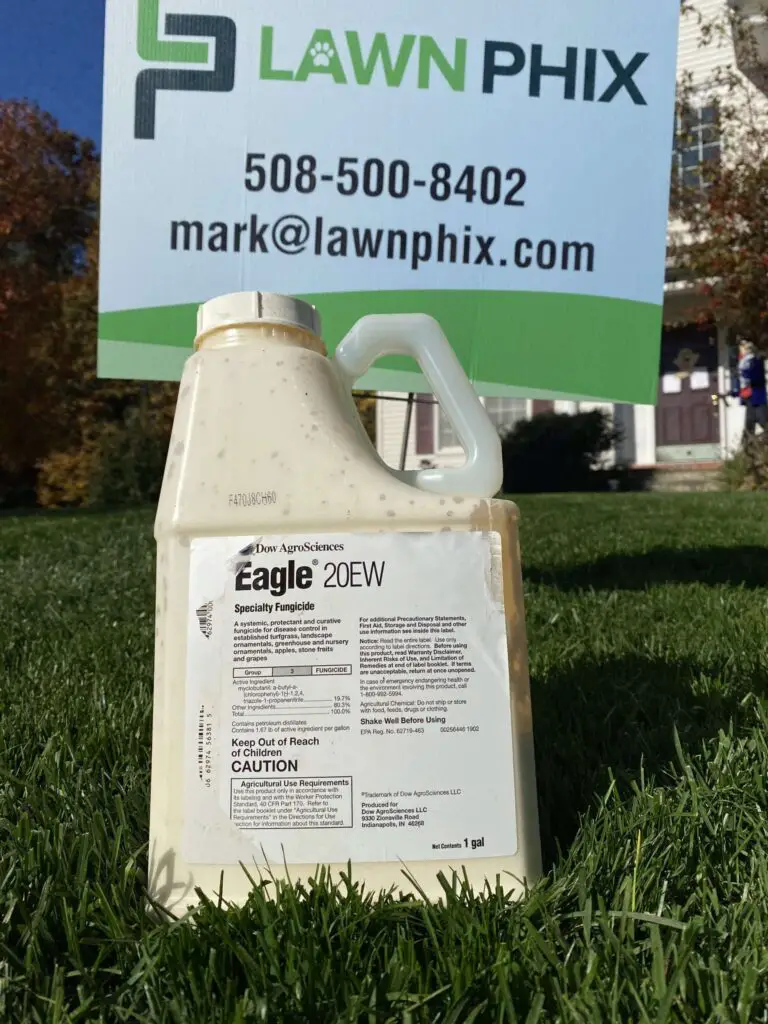
- Active Ingredients: Myclobutanil
- Target Funguses: Brown Patch, Dollar Spot, Red Thread, Necrotic Ring Spot, Leaf Spot, Powdery Mildew, Red Thread, Rust
- FRAC Group 3
Since Clearys has some restrictions, we threw in a bonus lawn fungicide here. Eagle 20EW is a FRAC 3 fungicide containing Myclobutanil. Eagle 20EW is a broad-spectrum systemic fungicide that targets over 15 different grass diseases. Rotate with Azoxystrobin (Artavia 2 SC) for a solid 1-2 punch against many diseases including Brown Patch. You can also find the generic version here.
Find the latest price on Eagle at Do My Own, Lawn Pro, DIY Pest, and Amazon.
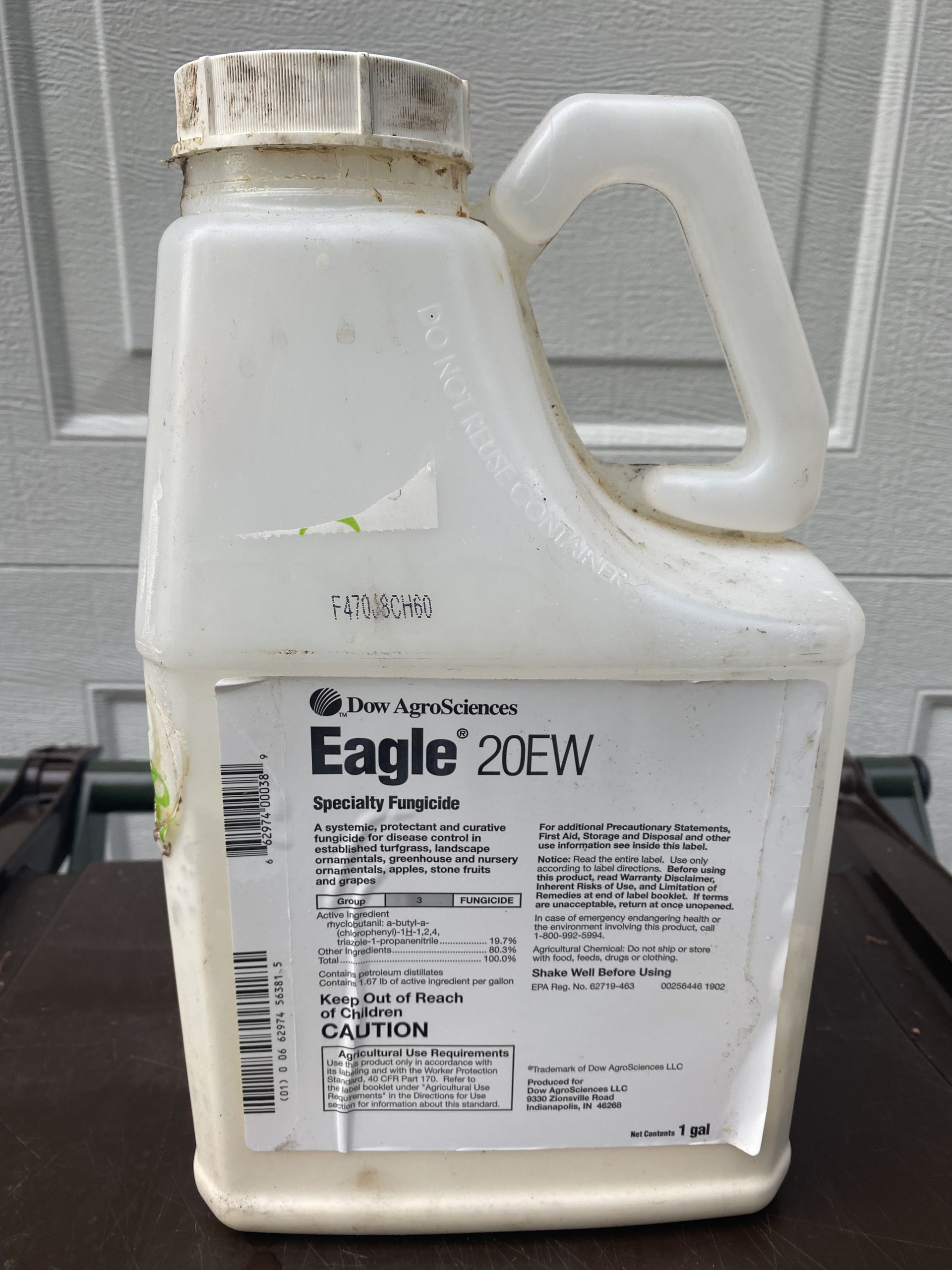
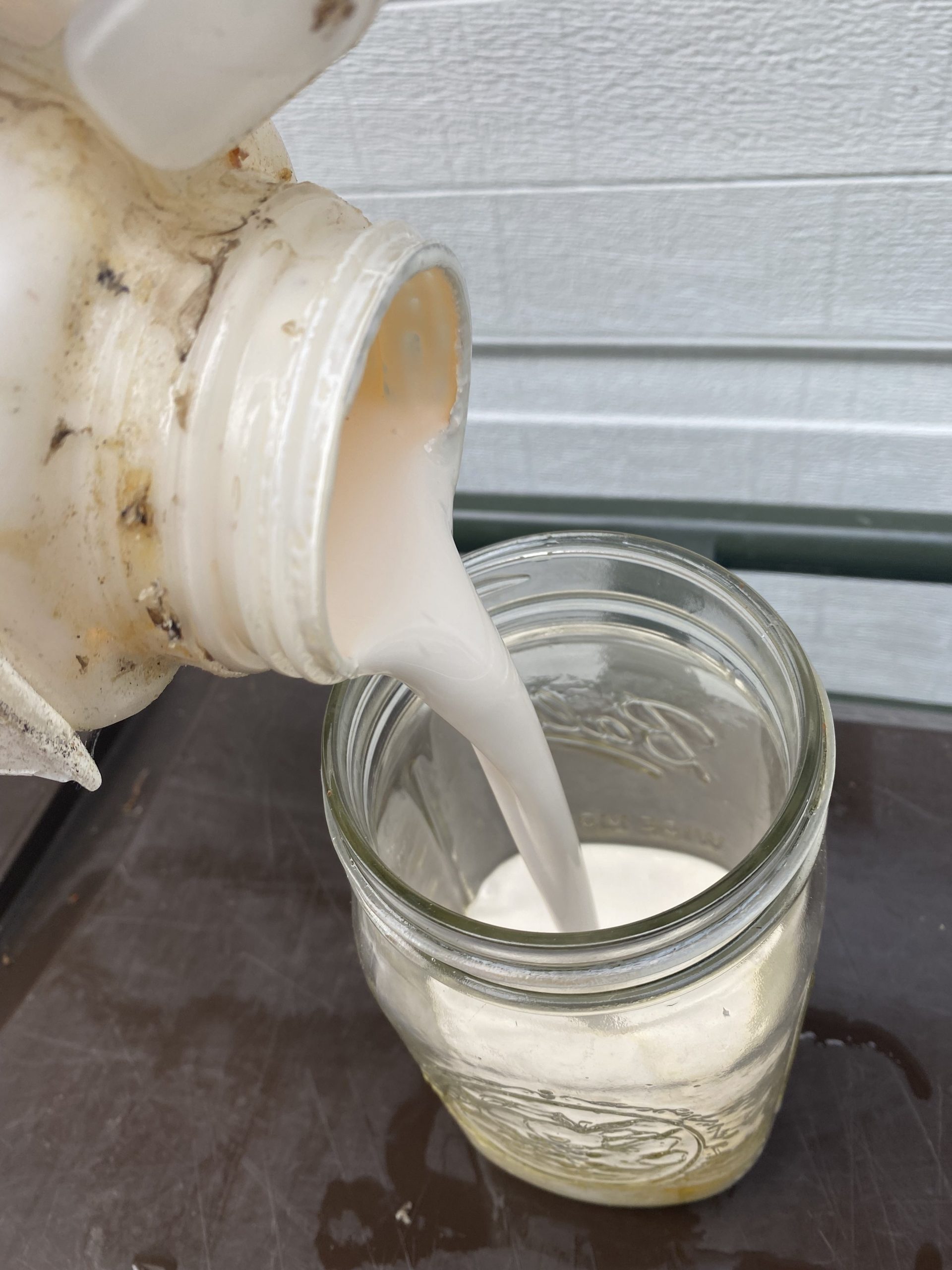
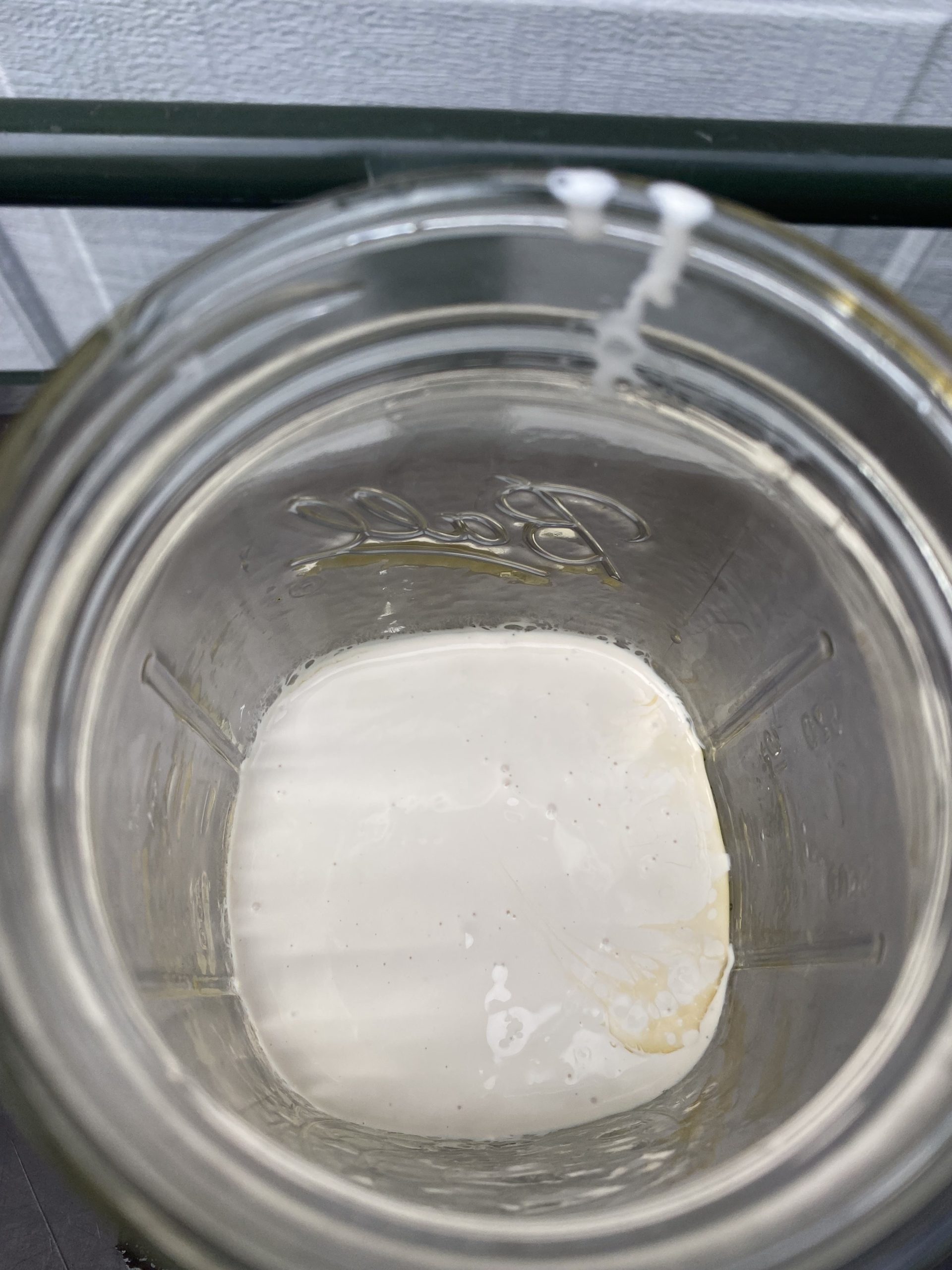
What Are Fungicides?
Fungicides are used in lawns to help prevent and control fungal diseases. Fungicides do not cure or fix the infected grass but do provide a curative response that helps stop the growth and spread of the disease in the plant. When left untreated, lawn diseases can kill the lawn to the point of needing full repairs.
Fungicides do not control or prevent insect damage. Follow the instructions on the fungicide label for long‐term protection and eradicate activity against lawn fungus and diseases.
Liquid fungicides are better than granular fungicides. When applied to the turf with an active lawn disease, these fungicides provide a “curative” response that helps stop or arrest the growth and spread of the fungus. When left untreated, lawn diseases can kill the lawn to the point of needing full repairs.
Liquids in particular have broad-spectrum control and provide protective, systemic, and curative activity. Because resistance can develop over time, rotating different modes of action is important. For example, rotate propiconazole and azoxystrobin (every other application).
Lawn Fungicide FAQs
How do you mix lawn fungicides?
To apply fungicides to lawns and turfgrass, fill the tank with half the total water needed. Next, pour in the measured amount of fungicide liquid. Last, fill with the remaining half of the water and agitate. If mixing directly into your tank, a paint mixer makes suspension quick and easy.
When should I apply fungicide prevention?
The risk of disease and fungus increases as the outside temperatures and humidity levels rise. A good rule of thumb is to add the outside temperature (Fahrenheit degrees) + humidity percentages. If that number is 150, then it’s time to apply. This is when fungus begins to thrive.
What fungicides should I buy at hardware stores?
Whenever possible, try buying liquid fungicides listed here first. The cost for these products is higher than those at the big box stores, but the cost per application is generally much cheaper. For example, Bayer Bio-Advanced contains propiconazole and is cheaper than 14.3, but the cost per application (1,000 sq. ft.) is about 3x ($5.20 vs. $1.81). We do not recommend Scotts DiseaseEx lawn fungicide.
How frequently can I apply fungicides?
Always read the labels. The application rates and intervals will always vary from product to product and which disease you’re targeting. Some fungicides can be applied as early as 7-10 days, while others can be 21-28 days.
How can I kill brown patch fungus and other diseases in my lawn?
It’s important to know that fungicides will help arrest or stop the fungus from spreading, and not “kill” the disease. Generally, turfgrass diseases start at the top of the grass blades and work their way down to the crowns – at which point will kill the grass. Fungicides will help prevent the growth of the disease, giving it more time to grow out.
What is the active ingredient in Scotts DiseaseEx?
The active ingredient in Scotts® DiseaseEx™ Lawn Fungicide is Azoxystrobin (0.31 %) with 99.69 % labeled other ingredients. Scotts DiseaseEx is a granular lawn fungicide that is best applied at maximum rates before lawn disease is present.
Fungicides on Amazon

